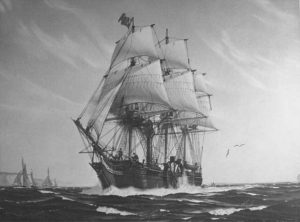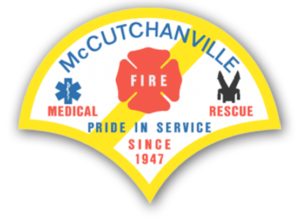
1819: The Arrival of the McCutchan Family
March 9, 1819
The first Irishman to settle the area of what would someday be known as McCutchanville would be a individual by the name of Charles McCutchan-Johnstone on March 1819. This man and his seven children had come from County Longford, Ireland right at the start of the massive wave of Irish immigration. He traveled down the Ohio River from Pittsburgh on flatboats until he reached the town of Evansville. He decided to continue his voyage up the Pigeon Creek until Stringtown Hill. Here he disembarked from his boats and traveled north up what would be known as Old State Road today. Before reaching Scott Township, Charles headed east down what is now know as Petersburg Rd until he reached the high hills of the future McCutchanville. Here he registered one-thousand acres from the Vincennes Land Office. His property extended from Petersburg Road as far east as Green River Road.
More About Charles McCutchan-Johnstone
So far as we know today the first white man to settle permanently in the McCutchanville area was a widower, Charles McCutchan-Johnstone, who came from County Longford, Ireland, with his seven children. The McCutchan-Johnstone famile sailed down the Ohio River from Pittsburgh on flat boats and landed in March 1819 at the crude little riverbank settlement called Evansville.
Things had not been going too well for Evansville. In 1819 the town had a population of about one hundred. Charles, with the sturdy spirit of a pioneer, left the settlement behind, turned his boats into Pigeon Creek, and pushed up into the wilderness as far as Skelhorn Hill (now Stringtown Hill) and disembarked. He had brought with him, besides some household goods, a wagon and two horses anda cow or two. Here at Skelhorn Hill he loaded his possessions on the wagon and headed northward on what was later know as the Older State Road running from Evansville to Vincennes. In 1819 and for some years after this was nothing more than winding path through the forest– a path from which the saplings and underbrush had been cut, but which had giant forest trees standing in its center along its entire course.
Instead of following the road northward into the area of Scott Township as earlier arrivals had done, Charles struck out earward on an Indian trail (now Petersburgh Rd), crossed the valley, and climbed the nezt ridge of hills. The hill country was a wise choice because the marshy valley lands along the creeks were malarial.
The land had been government property since the Indian treaties and was open to claim. He registered approximately one thousand acres at the Vincennes Land Officer. Hi named his estate Goshen after the village that had been his home in Ireland. It is believed that the property extended from the Petersburg Rd east to Green River Rd. There is no record of exactly where to find the first house built.
It must have been lonely for the first year being the only family for miles. How Mr. McJohnstone managed is difficult to imagine. is oldest son was only thirteen years old, and the oldest daugher only seven. The youngest child was just four. One may wonder why a widower with seven small children would have attempted such a long and difficult journey. It seems that the real reason he came to America in the firs place was to escape trouble he was having with the courts in Ireland.
In 1816 he had killed a man. As the story goes, he owned a shop in the town of Granard, and one night, discovering someone prowling in the shop, he got his gun and shoe the intruder dead. It turned out that man was on of his employees. McJonhston was cleared of a murder charge, but was sentenced to assume the maintenance and guardianship of the victim’s family. A Litter form an attorney in Dublin addressed to Charles, dated 1816, warned him that he had no other alternative, excerpt to go to jail. There was, however, another alternative. That was to sell out and go to America, which he did two years later.
After the death of his wife, July 17, 1817, Charles took his seven children and sailed for America, landing in Philadelphia in August 1818. He left his children in that city for awhile and spent some time searching for a location in the state of New York. Failing to find a site that he liked, he purchased wagons and made the journey with his children across the moutains to Pittsburgh. The trip took more than four weeks. In Pittsburgh he built a flat boat and started fown the Ohio River. Winter came on early, and before they had gone too far, he landed at a place called Beaver Dam, sold his boat, and awaited the spring.
When the good days came again, he built two boats, on one of which he placed his family and household goods and on the other his wagon and animals, and continued the journey down the Ohio to Evansville where he landed on March 25, 1819.
